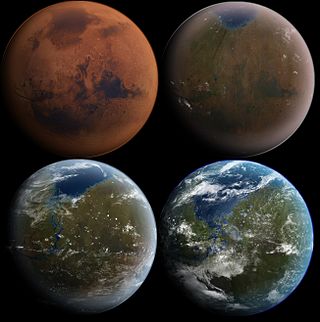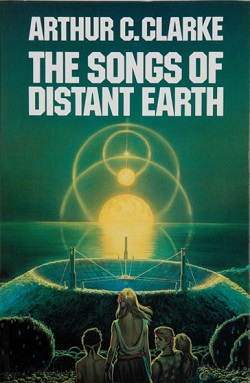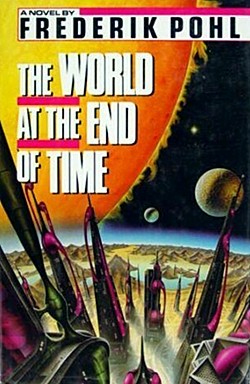
Heretics of Dune is a 1984 science fiction novel by Frank Herbert, the fifth in his Dune series of six novels.

Terraforming or terraformation ("Earth-shaping") is the hypothetical process of deliberately modifying the atmosphere, temperature, surface topography or ecology of a planet, moon, or other body to be similar to the environment of Earth to make it habitable for humans to live on.
The concept of self-replicating spacecraft, as envisioned by mathematician John von Neumann, has been described by futurists and has been discussed across a wide breadth of hard science fiction novels and stories. Self-replicating probes are sometimes referred to as von Neumann probes. Self-replicating spacecraft would in some ways either mimic or echo the features of living organisms or viruses.

The Songs of Distant Earth is a 1986 science fiction novel by British writer Arthur C. Clarke, based upon his 1958 short story of the same title. Of all of his novels, Clarke stated that this was his favourite. Prior to the publishing of the novel, Clarke also wrote a short step outline with the same title, published in Omni magazine and anthologised in The Sentinel in 1983.
Planetary engineering is the development and application of technology for the purpose of influencing the environment of a planet. Planetary engineering encompasses a variety of methods such as terraforming, seeding, and geoengineering.

Karl Schroeder is a Canadian science fiction author and a professional futurist. His novels present far-future speculations on topics such as nanotechnology, terraforming, augmented reality, and interstellar travel, and are deeply philosophical. More recently he also focuses on near-future topics. Several of his short stories feature the character Gennady Malianov.

World at the End of Time is a 1990 hard science fiction novel by American writer Frederik Pohl. It tells the parallel stories of a human and a plasma-based intelligence who manage to survive to the time near the heat death of the universe. The book is thus a combined work in speculative cosmology and space colonization.
Technogaianism is a bright green environmentalist stance of active support for the research, development and use of emerging and future technologies to help restore Earth's environment. Technogaianists argue that developing safe, clean, alternative technology should be an important goal of environmentalists and environmentalism.

The Saga of Seven Suns is a series of seven space opera novels by American writer Kevin J. Anderson, published between 2002 and 2008. The books are set in a not-too-distant future where humans have colonized a number of other planets across the galaxy, thanks in part to technological assistance from an ancient alien race, the Ildirans. The series chronicles the universe-spanning war that erupts when humans inadvertently ignite the fury of a hidden empire of elemental aliens known as the hydrogues. Internal conflict is sparked within both the human and Ildiran empires as other ancient elemental races reappear to renew their own ancient war with the hydrogues.
Seed was a massively multiplayer online role-playing game (MMORPG) developed by Danish studio Runestone Game Development. Aiming for a radically different experience than most other games in the genre, the game focused on character interaction and politics to the extent that combat was entirely removed from the design.
The use of nanotechnology in fiction has attracted scholarly attention. The first use of the distinguishing concepts of nanotechnology was "There's Plenty of Room at the Bottom", a talk given by physicist Richard Feynman in 1959. K. Eric Drexler's 1986 book Engines of Creation introduced the general public to the concept of nanotechnology. Since then, nanotechnology has been used frequently in a diverse range of fiction, often as a justification for unusual or far-fetched occurrences featured in speculative fiction.

Building Harlequin's Moon is a science fiction novel by Larry Niven and Brenda Cooper. The novel is set in the distant future as a group of space travellers, marooned in an inhospitable planetary system, attempt to terraform a moon and create a sufficient civilisation on it to refuel their ship so they can continue to their original destination.
The Alliance–Union universe is a fictional universe created by American writer C. J. Cherryh. It is the setting for a future history series extending from the 21st century into the far future.

Lovelock is a 1994 science fiction novel by American writers Orson Scott Card and Kathryn H. Kidd. The novel's eponymous narrator, a sentient monkey, takes his name from James Lovelock, the scientist-inventor who formulated the Gaia hypothesis, which figures heavily in the book.
The ethics of terraforming has constituted a philosophical debate within biology, ecology, and environmental ethics as to whether terraforming other worlds is an ethical endeavor.

Spin is a science fiction novel by American-Canadian writer Robert Charles Wilson. It was published in 2005 and won the Hugo Award for Best Novel in 2006. It is the first book in the Spin trilogy, with Axis published in 2007 and Vortex published in July 2011.

UFO: Afterlight is a 2007 real-time tactics/turn-based strategy video game and the third in Altar Games' UFO series. Like its predecessors UFO: Aftermath and UFO: Aftershock, it combines squad-level tactical combat with overlying strategic elements inspired by the 1994 classic X-COM: UFO Defense.

Probability Sun is a 2001 science fiction novel by American writer Nancy Kress, a sequel to her 2000 publication Probability Moon. It was followed in 2002 by Probability Space, which won the John W. Campbell Memorial Award.
The Revelation Space series is a book series created by Alastair Reynolds. The fictional universe it is set in is used as the setting for a number of his novels and stories. Its fictional history follows the human species through various conflicts from the relatively near future to approximately 40,000 AD. It takes its name from Revelation Space (2000), which was the first published novel set in the universe.

Permanence is a 2002 science fiction novel by Canadian writer Karl Schroeder.












